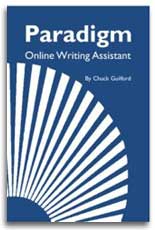Editing
Producing a clean, error-free final draft isn't easy. Even the most carefully edited professional publications contain occasional typos. Most readers understand this and aren't bothered by such infrequent problems. Yet when errors occur often, they undermine the writer's authority and disrupt communication.
It's helpful to think of grammar and mechanics as matters of convention or mutual agreement among language users. Such agreement is necessary for language to work. To communicate with even the simplest words, for example, we must agree on their meaning. Conventions of grammar come partly from tradition and partly from a need to be clear and accurate. And like other conventions, rules of grammar change continually.
Our language organizes thoughts into sentences. As a core, these sentences have a two-part structure. For simplicity and easy reference, we can represent the two parts as follows:
Writing made up of only such little sentences would quickly grow monotonous and would also sound like it had been written by someone without much language experience. Fortunately, the basic S V/C pattern allows for easy expansion in almost unlimited ways.
The following guidelines are easier for some to follow than for others, but they can, with a little work, be learned by almost anyone. Once learned, they'll become part of your permanent knowledge base like the multiplication tables or your best friend's phone number. You won't have to learn them twice.
Page 1 of 2



